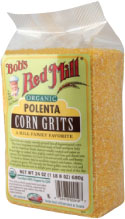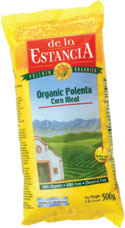Polenta at PCC
This article was originally published in February 2011
We have thick-grain polenta, one with a finer grind, and some that are already made and packaged, ready to eat. All are organic. So whether you have an hour, 10 minutes, or no time at all to cook, you’ll find we carry this versatile food in a form that will fit your needs and make a delicious foundation for any meal — breakfast through dessert!

Bob’s Red Mill corn grits polenta
The coarse grain of this organic polenta (available in bulk and packaged at PCC) makes it ideal for slow cooking, and will lend your dish a pronounced flavor and texture.
Quick bite: “I like a rustic, hearty polenta — which this delivers,” says PCC’s Goldie Caughlan. “When it’s done cooking I pour it thickly onto a platter and top it with sautéed seasonal veggies or canned black beans. Sometimes I add a little feta on top.” For a sweet treat, Goldie pours the polenta into a loaf pan, chills it, then slices and sautés it and eats it drizzled with maple syrup.
De la Estancia polenta

This organic polenta is unique in that it cooks more quickly than most polentas. That’s because it’s made with a sub-tropical variety of orange-yellow corn from Argentina called “flint” corn, which can’t grow in the Northern Hemisphere. Flint corn requires up to 7 months in the field, including a period of natural drying in the sun — nearly twice as long as the corn grown in the United States.
Flint corn is harder, has a higher protein content, and has less starch. This allows for a finer grind, which means De la Estancia polenta can cook much faster than traditional polenta.
To prepare, boil the water, add the polenta in a slow stream, whisking all the while, and keep whisking until the polenta begins to thicken. Then lower the heat, and keep simmering. It’ll be ready in a few minutes, but you can keep simmering it until you’re ready to eat.
Quick bite: “I love De la Estancia polenta for the smooth, silky texture,” says PCC’s [former] nutrition educator, Leika Suzumura. “I cook it with equal amounts amaranth and oat bran with melted coconut butter (not oil) and a touch of honey for a super fast, easy, delicious, and nutritious breakfast.”
Food Merchant prepared polenta

Don’t have time to cook polenta? You can buy it ready-made in convenient “logs” in the refrigerated sections at PCC. It’s organic, gluten-free and fat-free, and comes in five flavors: Traditional Italian, Sundried Tomato-Garlic, Basil-Garlic, Chili-Cilantro and Mushroom-Onion.
Quick bite: Cut a log into slices 1/2- to 3/4-inch thick, then bake, broil, pan-fry or grill, following the instructions for any recipe you wish. Top with your favorite sauce, beans or stews.
Polenta tips and cooking
Tip #1: Don’t freeze polenta
The reason is that the water separates, leaving you with polenta that’s grainy, crumbly and sponge-like. Keep an opened package of polenta in your refrigerator and use it within about a week.
Tip #2
Pour leftover polenta into a small container and let it chill overnight, uncovered. There’s no need to oil the container first, as the polenta will still pop right out once it sets. Slice it about a half-inch thick and fry it in a nonstick pan filmed with oil until the polenta is speckled brown and its edges have crisped.
Cooking tips
Polenta is easy to make from scratch but it’s also easy to encounter lumps, burns and difficult cleanups. Here are some tips for a creamy, smooth result:
- Polenta needs to be stirred, but not constantly. Stirring it for one full minute every 10 minutes (up to an hour for coarse grain polenta, 5 minutes for fine grain) is sufficient.
- Use a heavy-bottomed pot to prevent scorching.
- Use a ratio of four parts water to one part polenta. This will allow it to be creamier and less bitter than if you use a 3:1 ratio.
- Add salt to the boiling water before you add the polenta. It’s much easier to season a starch as it absorbs water rather than at the end of cooking.
- Prevent lumps by whisking the polenta as you add it to the boiling water. Once the polenta is incorporated, turn the heat to low and whisk a few more times in the first 10 minutes.
- For simple cleanup, fill the polenta pot overnight with cold water and any crust should peel off the bottom the next day.
